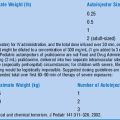Chapter 63 Bites and Stings
1 True or false: Bites from imported fire ants (Solenopsis invicta) can cause severe systemic reactions
deShazo RD, Williams DF, Goddard J, et al: Medical consequences of stings of imported fire ants, 2006: www.uptodate.com
3 What are the common microbiological organisms of dog, cat, and human bites?
4 Which bites should be routinely treated with prophylactic antibiotics?
8 How does rat-bite fever present?
Fatal rat-bite fever—Florida and Washington, 2003. MMWR Morb Mortal Wkly Rep 53:1198–1202, 2005.
13 Name the tick-borne infectious diseases that occur in the United States
14 In penicillin-allergic patients who present with a human bite or a high-risk animal bite, what antibiotic regimen is recommended?
17 How are reactions to bee stings categorized?
 The most common reaction is a small local reaction that presents as a painful pruritic lesion < 5 cm at the site of the sting and lasts briefly (several hours).
The most common reaction is a small local reaction that presents as a painful pruritic lesion < 5 cm at the site of the sting and lasts briefly (several hours).
 A large local reaction occurs in approximately 10% of people after a sting and manifests with swelling and erythema in the area of the sting. It is usually > 5 cm in diameter, often very painful and itchy, and lasts for > 24 hours, sometimes up to 1 week. The features of this reaction may be confused with cellulitis, but cellulitis rarely develops after a bee sting.
A large local reaction occurs in approximately 10% of people after a sting and manifests with swelling and erythema in the area of the sting. It is usually > 5 cm in diameter, often very painful and itchy, and lasts for > 24 hours, sometimes up to 1 week. The features of this reaction may be confused with cellulitis, but cellulitis rarely develops after a bee sting.
 Systemic reactions, which occur in approximately 0.5% of Hymenoptera stings, begin within minutes to hours after the sting and can be mild or severe.
Systemic reactions, which occur in approximately 0.5% of Hymenoptera stings, begin within minutes to hours after the sting and can be mild or severe.
 Mild systemic reactions most commonly consist of dermal signs and symptoms: generalized urticaria, pruritus, flushing, and angioedema. Gastrointestinal symptoms, such as abdominal pain, nausea, and diarrhea, may also occur.
Mild systemic reactions most commonly consist of dermal signs and symptoms: generalized urticaria, pruritus, flushing, and angioedema. Gastrointestinal symptoms, such as abdominal pain, nausea, and diarrhea, may also occur.
 Severe systemic reactions include life-threatening signs, such as upper airway edema with hoarseness and stridor; shock, manifested by pallor and fainting; and bronchospasm, characterized by coughing, dyspnea, and wheezing.
Severe systemic reactions include life-threatening signs, such as upper airway edema with hoarseness and stridor; shock, manifested by pallor and fainting; and bronchospasm, characterized by coughing, dyspnea, and wheezing.
 Unusual reactions to bee stings include vasculitis, nephrosis, encephalitis, and serum sickness. Symptoms usually occur several days to several weeks after the sting and tend to last for a long time.
Unusual reactions to bee stings include vasculitis, nephrosis, encephalitis, and serum sickness. Symptoms usually occur several days to several weeks after the sting and tend to last for a long time.
19 What is the treatment for anaphylaxis due to an insect sting?
Vankawala H, Park R: Bee and Hymenoptera stings: www.emedicine.com/emerg/topic55.htm
22 How are scorpion envenomations treated?
Bush S, Gerardo C: Scorpion envenomations: www.emedicine.com/emerg/topic524.htm
23 What are the four kinds of sharks in the United States that are responsible for most shark bites?
27 What is latrodectism?
 The exacerbation phase, which occurs from < 6 up to 24 hours and is characterized by muscle spasms at the site of the bite or elsewhere
The exacerbation phase, which occurs from < 6 up to 24 hours and is characterized by muscle spasms at the site of the bite or elsewhere
 The dissipation phase, which occurs 1–3 days after the bite and is a time when symptoms subside
The dissipation phase, which occurs 1–3 days after the bite and is a time when symptoms subside
 The residual phase, which occurs weeks to months after the bite and may consist of persistent tremors and weakness and fatigue
The residual phase, which occurs weeks to months after the bite and may consist of persistent tremors and weakness and fatigue
33 How does tularemia present? How is it treated?
The treatment is streptomycin. Gentamycin is an effective alternative.
39 What are the most effective precautions to avoid Lyme disease?
 Personal protection consists of wearing appropriate clothes: Wear long sleeves and long pants in at-risk areas.
Personal protection consists of wearing appropriate clothes: Wear long sleeves and long pants in at-risk areas.
 Use of repellants: DEET applied to the skin and clothes. Consider the use of Permethrin applied to the clothes in conjunction with DEET.
Use of repellants: DEET applied to the skin and clothes. Consider the use of Permethrin applied to the clothes in conjunction with DEET.
 Inspection: Parents should inspect their children after times spent in risky areas. If a tick is found on the skin, washing can be effective before attachment occurs.
Inspection: Parents should inspect their children after times spent in risky areas. If a tick is found on the skin, washing can be effective before attachment occurs.
 Modification of outdoor environment: Replace brush with wood chips.
Modification of outdoor environment: Replace brush with wood chips.















